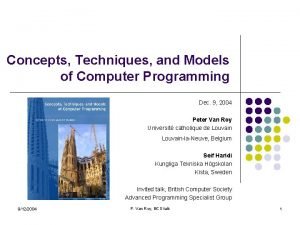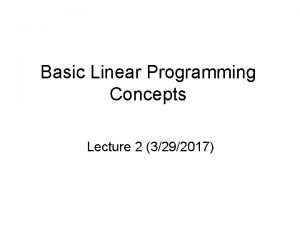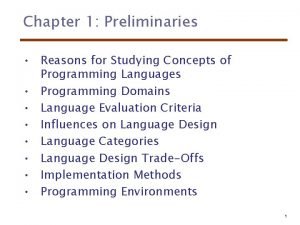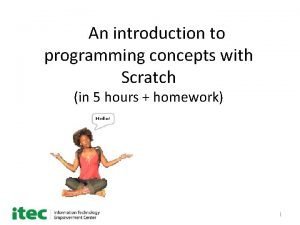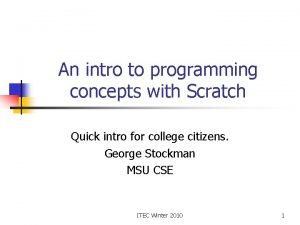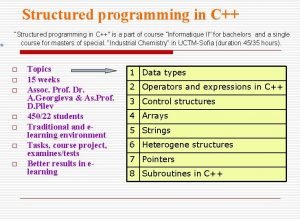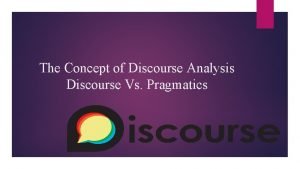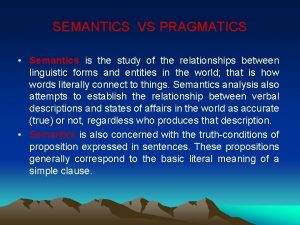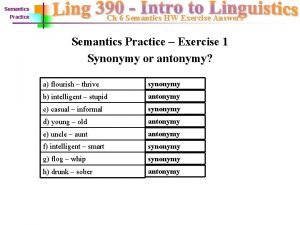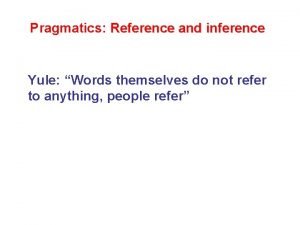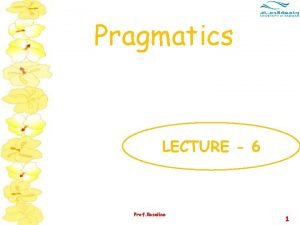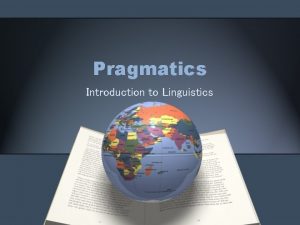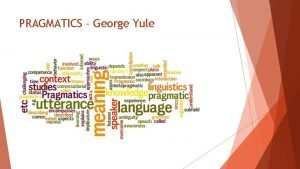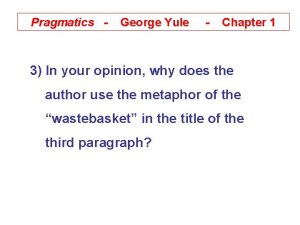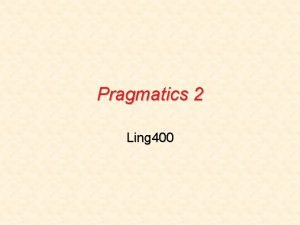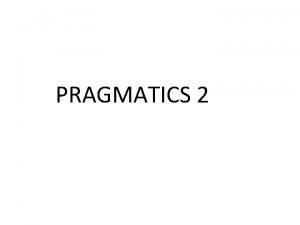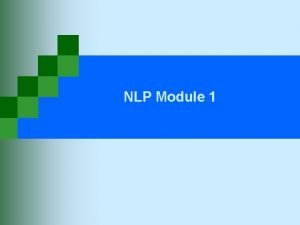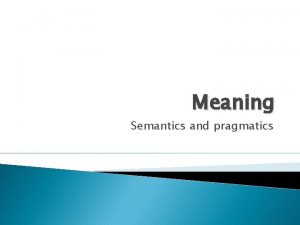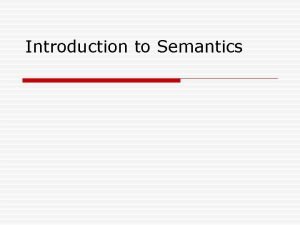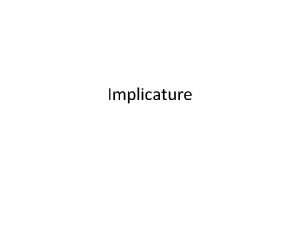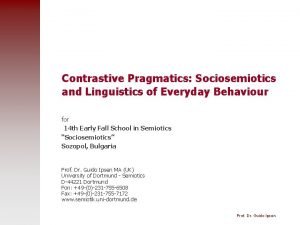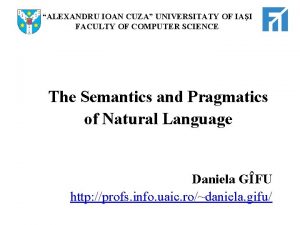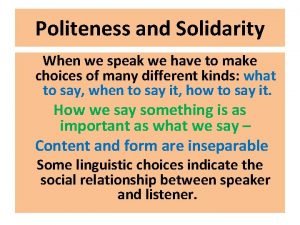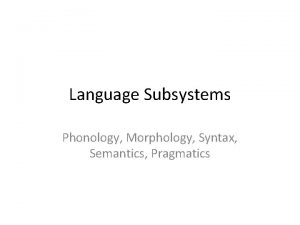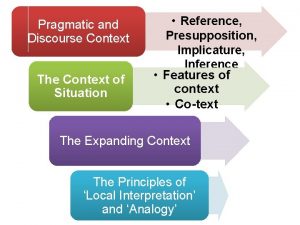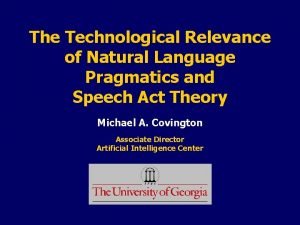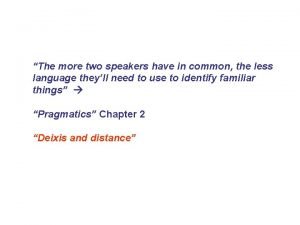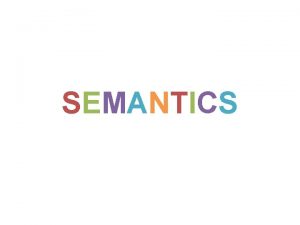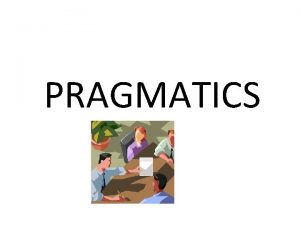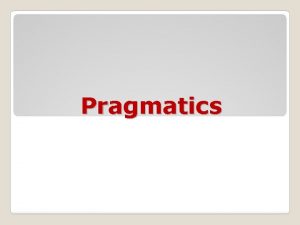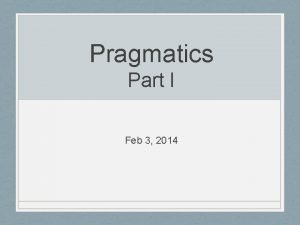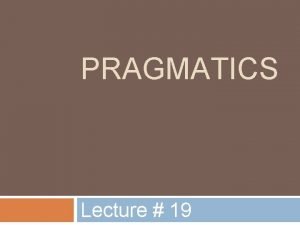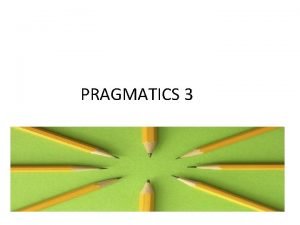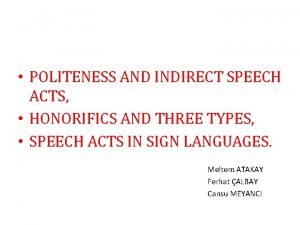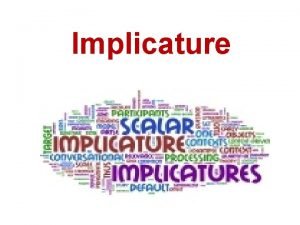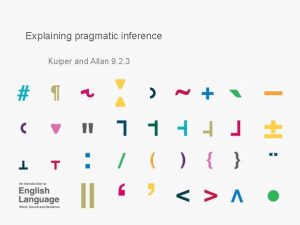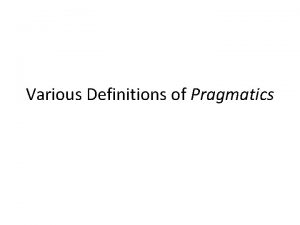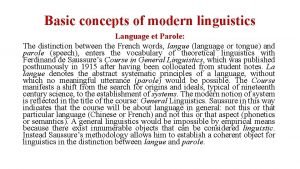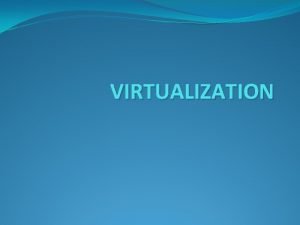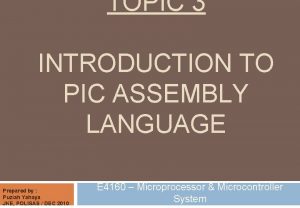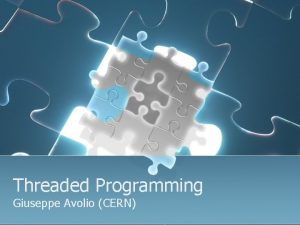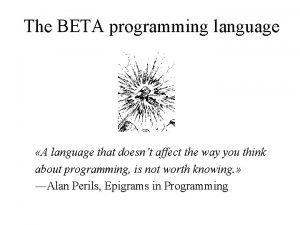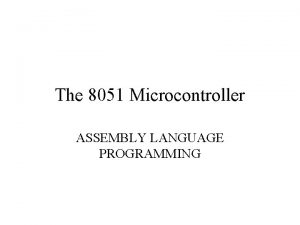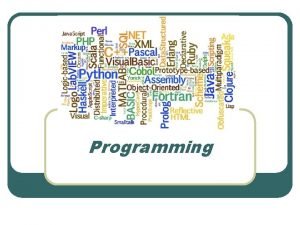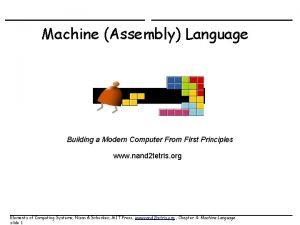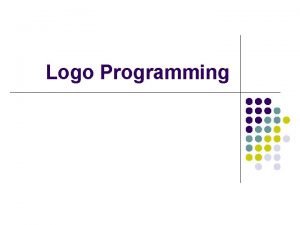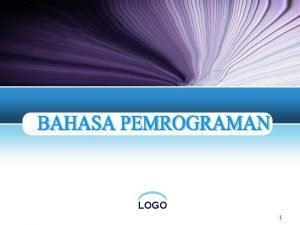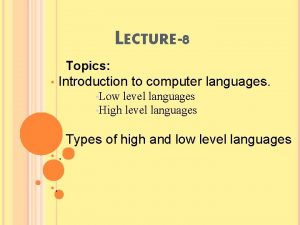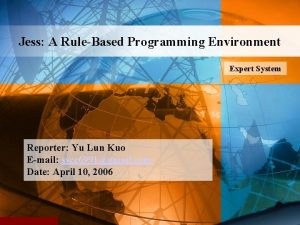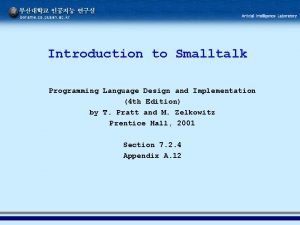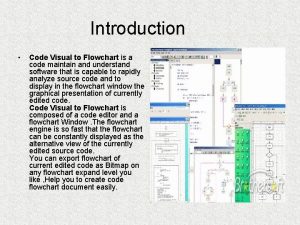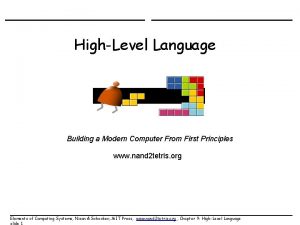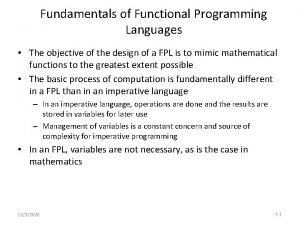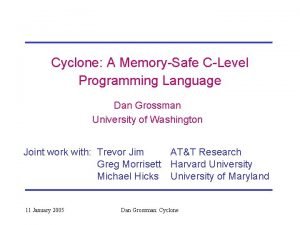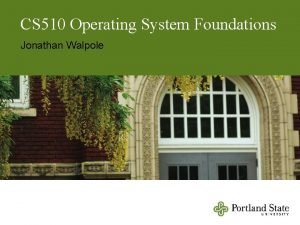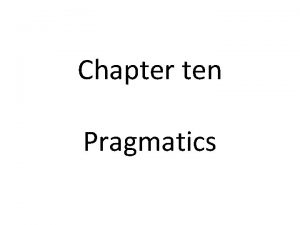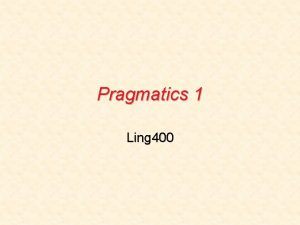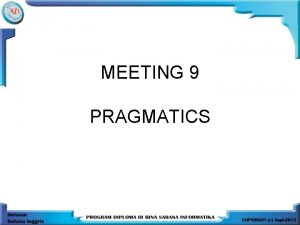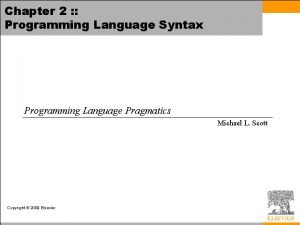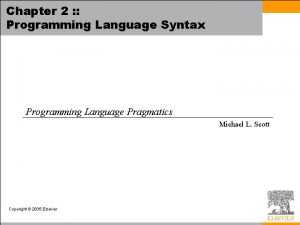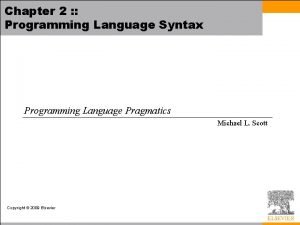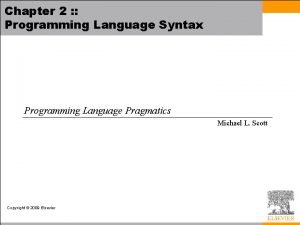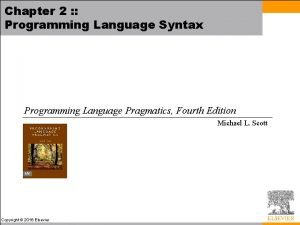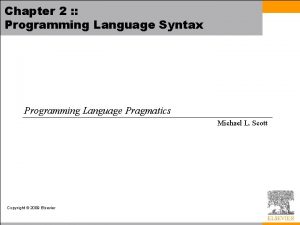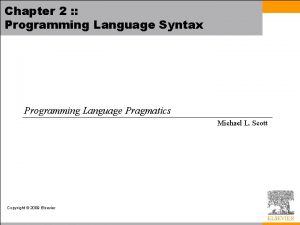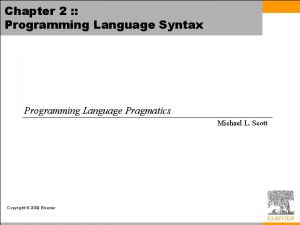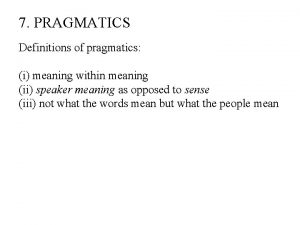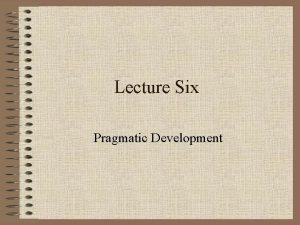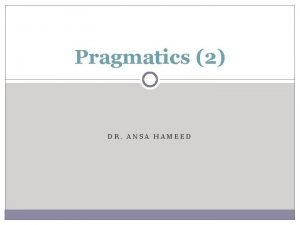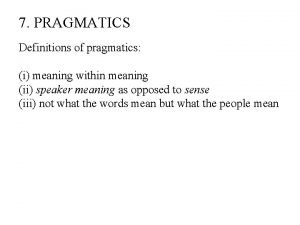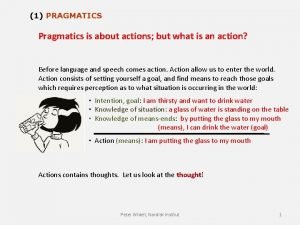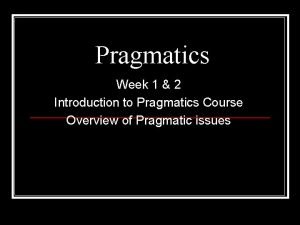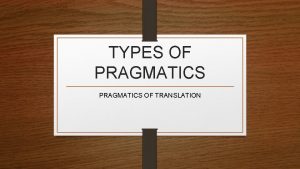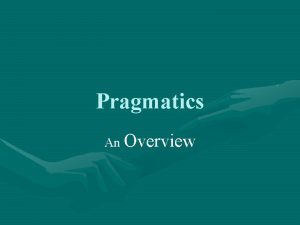Programming Language Concepts 1 Programming Language Pragmatics Michael


































































- Slides: 66

Programming Language Concepts 1

Programming Language Pragmatics Michael Scott http: //www. cs. rochester. edu/u /scott/pragmatics/ 2

Contents 1 Introduction 2 Programming Language Syntax 2. 1 Specifying Syntax 2. 2 Recognizing Syntax 2. 3* Theoretical Foundations 3

3 Names, Scopes, and Bindings 3. 1 The Notion of Binding Time 3. 2 Object Lifetime and Storage Management 3. 3 Scope Rules 3. 4 The Binding of Referencing Environments 3. 5 Overloading and Related Concepts 3. 6 Naming-Related Pitfalls in Language Design 4

4 Semantic Analysis 5 Assembly-Level Computer Architecture 6 Control Flow 6. 1 Expression Evaluation 6. 2 Structured and Unstructured Flow 6. 3 Sequencing 6. 4 Selection 6. 5 Iteration 6. 6 Recursion 5

7 Data Types 7. 1 Type Systems 7. 2 Type Checking 7. 3 Records (Structures) and Variants (Unions) 7. 4 Arrays 7. 5 Strings 7. 6 Sets 7. 7 Pointers and Recursive Types 7. 8 Lists 6

8 Subroutines and Control Abstraction 8. 1 Review of Stack Layout 8. 2 Calling Sequences 8. 3 Parameter Passing 8. 4 Generic Subroutines and Modules 8. 5 Exception Handling 8. 6 Coroutines 7

9 Building a Runnable Program 10 Data Abstraction and Object Orientation 11 Alternative Programming Models: Functional and Logic Languages 12 Concurrency 13 Code Improvement 8

Introduction § Computing devices 9

§ Machine language binary system 10

§ coding in the true meaning of the word § code is not § reusable: monolithic ‘structure’ § relocatable: consider adding one instruction in the middle § readable § practically impossible to create large programs 11

§ Assembly languages assembler 12

§ Assembler § translator from symbolic language to machine language (one-to-one mapping) § tool to assemble the symbolic program in the machine § Advantages § relocatable & reusable (copy) programs § macro expansion § first step towards higher-level programming § larger programs (like operating systems) possible 13

§ But, § each kind of computer has its own § programmers must learn to think like computers § maintenance of larger programs is difficult § Higher-level languages § portability § natural notation (for anything) § support to software development 14

§ Machine independent languages § Fortran 1956 § Cobol 1959 § Algol 1958, 1960 §. . . § compilers 15

16

§ Fortran (Mathematical Formula Translator) § Backus, 1957 § IBM § compilation instead of translation § language for scientific computing § most important task in those days § efficiency important to replace assemblers § introduced many important language concepts that are still in use § Fortran 99 array operations 17

§ Cobol (Common Business Oriented Language) § 1959 § COBOL commetee (IBM, Honeywell, Flow. Matic, . . . ) § at some point 60% of all business applications 18

§ Algol 60 (Algorithmic Language) § the first European language § never very present in practice § introduced modern concepts § big influence on further development § Ada § Basic (Beginers All-purpose Symbolic Instruction Code) § 1961 § popular in the eighties § Visul Basic, Visual Basic for Application 19

§ PL/1 (Programming Language One) § general-purpose § meant to replace Fortran, Cobol and Algol § Algol 68 § the same idea of universality § too complex § hardware could not support them § Algol 68 compiler never completely realized 20

§ Pascal § N. Wirth § late sixties § simple to learn, easy to use, . . . § introduces subrange and enumeration types, unified structures, unions § ’Pascal-like’ notion § Turbo Pascal § free availability § Modula 21

§ an analysis from the beginning of seventies § § § for the next 15 -20 years predicted software cost not in proportion to hardware cost about 450 languages § ADA § § § 1983 new attempt for the universal language US DOD too big expectations never fulfilled theoreticaly significant, data types, moduls, abstraction, concurrency, exception handling 22

§C § 1970 § UNIX, system software programming § 1978 D. M. Ritchi and B. W. Kernighan § 1983 ANSI C § close to assembly languages § not reliable, weak type checking, no dynamic semantic checks § C++ 23

§ object-oriented languages § data abstraction § objects, classes § inheritance, polimorphism § roots in Simula 67 § Smalltalk 80, Eiffel, Omega, Oberon, C++, Delta, Java § visul environment, interactive, § events driven programming: Visual Basic, Delphi 24

Language classification § imperative § how the computer should solve the problem § first do this, then repeat that, then branch there. . . § procedural languages (Pascal, C, Basic, . . . ) § ‘computing via side-effects’ § Von Neumann architecture (1946) § object-oriented 25

§ declarative languages § program = description of the problem § a formal statement of what is the problem § closer to humans than computers § functional languages § Lisp, 1958 § λ-calculus, Church 1930 § computing without variables § logic programming § predicate logic, Fredge 1871 § Prolog, seventies § computing with relations 26

The programming language spectrum 27

§ sequential § concurrent § in conjuction with sequential (Fortran, C, . . . ) § explicite (Java, Ada, Modula-3) 28

Why so many languages? § evolution goto while, case, . . . object-oriented § special purposes symbolic data – Lisp character strings – Snobol, Icon low-level programming – C numeric data – Fortran logic programming - Prolog § personal preference iteration : recursion pointers : implicit dereferencing 29

What makes a language successful? § expressive power § ease of use for a novice Basic, Logo, Pascal, Java, . . . § ease of implementation § excellent compilers Fortran § economics, patronage, inertia Cobol § programming vs. implementation conceptual clarity vs. implementation efficiency 30

Language characteristics formally defined syntax (grammars, syntax diagrams) data types (predefined, others) data structures (array, record, file, set) control (if, case, for, while) subroutines 31

modules abstract data types data + procedures + functions closed concurrency parallelism low-level mechanisms to access registers, memory, format data exception handling mechanisms I/O procedures 32

Evaluating languages § readability § more readable less documentation § factors: key words. . modularity degree § simplicity num = num + 1 num += 1 ++num num++ 33

§ readability (still. . . ) § orthogonality § small number of concepts and ways to combine them § control flow § structural languages § data structures § records more clear than arrays § syntax § begin. . end, if. . fi (end if) 34

§ easy of use § depends on the application § simplicity and orthogonality § programmers accept limitted number of new concepts § small numbers of concepts and constructs § abstraction support § emphasses global characteristics § subroutines, modules, classes § expressivity § num = num + 1 or num++ § while or for 35

§ reliability § § § to decrese number of run-time errors early binding data types § explicitly defined § operators types determined § casting § exceptions handling § run-time errors caused by the program or system § aliasing § mutual references to the same memory location § Fortran: equivalence § Pascal: pointers § may cause errors 36

§ effectivity § of a program § important for real-time systems § of the compiler § important for often modified programs § overall § important for widely used software 37

Why to study programming languages? § interesting, practical § choose the most appropriate language § scientific applications, system software, embedded systems, word processor § C, Fortran, Java, Ada, Visual Basic, Modula-2 § easier to learn new languages § § § C → C++ → Java Pascal → Modula-2 common concepts: types, control, naming, abstraction 38

Our aim is to: § Understand obscure features § C: unions, arrays vs. pointers, separate compilation, varargs, . . . § understanding the basic concepts is a necessity to understand non-basic ones § Choose the best alternative depending on implementation costs § alternative ways of doing the same thing § x * x or of x**2 § pointer arithmetic or arrays § computation vs. memory (function or table) § things to avoid § Pascal & value parameters for large types Make good use of the environment 39

§ Simulate features where they do not exist § Fortran (pre -90) § bad control structures use comments & programmer discipline § no recursion eliminate recursion § no named constants use variables § C, Pascal § no modules use naming & discipline § Equip with basic knowledge for further study of language design and implementation, or interactions of languages with operating systems 40

§ Useful in designing command interpreters, programmable editors, text processors, . . . § Many system programs are like languages § command shells § programmable editors § programmable applications § Many system programs are like compilers § read & analyze configuration files and command line options § Easier to use and design such things once you know about ‘real’ languages 41

Compilation and interpretation 42

§ Interpretation § greater flexibility § better diagnostics § excellent source-level debugger § cope with variables’ sizes, types, names § write and execute on fly program pieces (Prolog, Lisp) § Compilation § better performance § saves time, memory 43

a mixture of both compilation or interpretation? 44

§ preprocessor (in interpreted languages) removes comments and white space, forms tokens, expand abbriviations, identifies highlevel structures § compilation § thorough analysis and nontrivial transformation 45

examples § Basic, pure interpreted § Fortran, pure compiled format interpreter 46

§C § preprocessor removes comments, expands macros, conditional compilation 47

§ C++ early AT&T compiler 48

§ Pascal early compilers: - a Pascal compiler written in Pascal the same compiler in P-code - a P-code interpreter written in Pascal 1. translate (by hand) the P-code interpreter into a local language 49

§ still both for Pascal, C, other imperative § late binding § Prolog, Lisp § Java, byte code (interpreter or just-in-time compiler) § Assembly languages run on interpreter § some compilers produce C-code § translating automaticaly from one nontrivial language to another § text processors, query language processors for databases 50

Programming environments § Assemblers, debuggers, preprocessors, linkers, editors, configuration management tools § Explicit request of the user (Unix) § Integrated enviroments (Smalltalk, Visual Studio env. ) 51

Overview of compiling § phases § front end figure out the meaning of the source program § back end construct target program 52

53

§ passes § a serialized set of phases § separate programs, input/output files § economic memory use § division such that § front end for more than one machine § back end for more than one language 54

Lexical and Syntax Analysis program gcd (input, output); var i , j : integer; begin read (i, j); while i<>j do if i>j then i : = i – j else j : = j – i; writeln (i) end. 55

§ scanner § lexical analysis § tokens: program, gcd, (, i, , , j, ), ; , . . . , end, . § removes comments, tags tokens with line and column numbers § parser § syntactic analysis § parse tree § CFG (context-free grammar) 56

program → PROGRAM identifier ( identifier more_identifiers ) ; block → labels constants types variables subroutines BEGIN statement more_statements END more_identifiers → , identifier more_identifiers | ε 57

58

Semantic Analysis Intermediate code generation § meaning § recognizes multiple occurances of an identifier, tracks types of identifiers and expressions § symbol table § identifier, type, internal structure, scope 59

60

§ checks that § identifiers defined before used § not used inappropriatelly § correct arguments in subrotine calls § arms in CASE distinct constants § exist return values for functions § semantic action routines invoked by parser 61

§ static semantics (at compile time) § dynamic semantics (at run time) § variables in expressions have values § pointers refer to valid objects § array subscript is in the bounds § functions return values § exception if a dynamic check fails § erroneous if a program breaks a rule expensive to be checked 62

parse tree (concrete syntax tree) ↓ syntax tree (abstract syntax tree) decorated by attributes, i. e. , pointers from identifiers to their symbolic table entries intermediate form between front and back end: - annotated syntax tree - traversal of some intermediate tree (resembles asembly language) 63

Target code generation: intermediate form → target language traverses the symbol table to assign locations to variables traverses the syntax tree generating loads and stores arithmetics, tests, branches 64

65

Code improvements § more efficient § quicker and/or less memory § two phases: § machine independent, on intermediate form § target program improvement, register distribution, reordering instructions 66
 Concepts techniques and models of computer programming
Concepts techniques and models of computer programming Linear programming basic concepts
Linear programming basic concepts Reasons for studying concepts of programming languages
Reasons for studying concepts of programming languages Scratch programming concepts
Scratch programming concepts Scratch programming concepts
Scratch programming concepts Stecheometry
Stecheometry Hardware description language vs programming language
Hardware description language vs programming language Discourse and text
Discourse and text Pragmatics vs semantics
Pragmatics vs semantics Semantic exercise meaning
Semantic exercise meaning Inference in pragmatics examples
Inference in pragmatics examples Pragmatics examples
Pragmatics examples Heated attendant parking meaning
Heated attendant parking meaning The performative hypothesis
The performative hypothesis Deixis and distance in pragmatics
Deixis and distance in pragmatics The pragmatic wastebasket
The pragmatic wastebasket Difference between semantics and pragmatics
Difference between semantics and pragmatics Implicature and entailment
Implicature and entailment Background and foreground entailment
Background and foreground entailment Pragmatic definition in linguistics
Pragmatic definition in linguistics Semantics summary
Semantics summary Semantic triangle example
Semantic triangle example Pragmatics examples
Pragmatics examples Implicature in pragmatics
Implicature in pragmatics Background knowledge context example
Background knowledge context example Guido ipsen
Guido ipsen Pragmatic examples
Pragmatic examples Solidarity and politeness
Solidarity and politeness Phonology morphology syntax semantics pragmatics
Phonology morphology syntax semantics pragmatics Context in pragmatics
Context in pragmatics Pragmatics
Pragmatics Discourse deixis
Discourse deixis Presupposition examples sentences
Presupposition examples sentences Spatial deixis
Spatial deixis What are pragmatics
What are pragmatics Person deixis examples
Person deixis examples Pragmatics
Pragmatics Attributable silence
Attributable silence Direct speech act
Direct speech act Language symbol in word
Language symbol in word Generalized implicature examples
Generalized implicature examples Relevance theory in pragmatics
Relevance theory in pragmatics Morris 1938 pragmatics
Morris 1938 pragmatics Perbedaan linear programming dan integer programming
Perbedaan linear programming dan integer programming Greedy algorithm vs dynamic programming
Greedy algorithm vs dynamic programming What is system programming
What is system programming Linear vs integer programming
Linear vs integer programming Definisi integer
Definisi integer Parole und langue
Parole und langue Machine reference model
Machine reference model Assembly language programming
Assembly language programming Pic assembly language programming examples
Pic assembly language programming examples Cern programming language
Cern programming language Beta programming language
Beta programming language Microcontroller assembly language programming
Microcontroller assembly language programming Example of lll
Example of lll Hack assembly language
Hack assembly language What is logo program
What is logo program Logo programmer
Logo programmer Machine language is a low level language
Machine language is a low level language Jess programming language
Jess programming language Small talk programming language examples
Small talk programming language examples Visual studio flowchart from code
Visual studio flowchart from code Language
Language Functional programming fundamentals
Functional programming fundamentals Cyclone programming language
Cyclone programming language Mesa semantics
Mesa semantics
